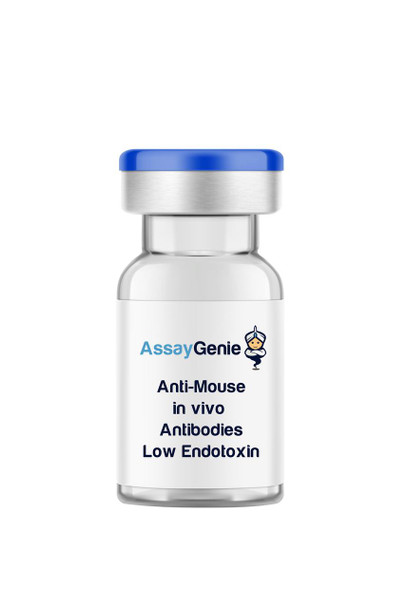Anti-Mouse Ly-6G In Vivo Antibody - Low Endotoxin
- SKU:
- IVMB0025
- Product Type:
- In Vivo Monoclonal Antibody
- Clone:
- 1A8
- Protein:
- Ly-6G
- Isotype:
- Rat IgG2a kappa
- Reactivity:
- Mouse
- Synonyms:
- Lymphocyte antigen 6 complex
- locus G
- Research Area:
- Immune Checkpoint & Cancer Biology
- Neutrophil Cell Depletion
- Endotoxin Level:
- Low Endotoxin
- Host Species:
- Rat
- Applications:
- CODEX
- CyTOF
- Depletion
- FC
- IHC FF
- WB
Description
| Product Name: | Anti-Mouse Ly-6G In Vivo Antibody - Low Endotoxin |
| Product Code: | IVMB0025 |
| Size: | 1mg, 5mg, 25mg, 50mg, 100mg |
| Clone: | 1A8 |
| Protein: | Ly-6G |
| Product Type: | Monoclonal Antibody |
| Synonyms: | Lymphocyte antigen 6 complex, locus G |
| Isotype: | Rat IgG2a κ |
| Reactivity: | Mouse |
| Immunogen: | Mouse Ly-6G transfected EL-4J cell line |
| Applications: | CyTOF®, Depletion, FC, IHC FF, PhenoCycler®, WB |
| Formulation: | This monoclonal antibody is aseptically packaged and formulated in 0.01 M phosphate buffered saline (150 mM NaCl) PBS pH 7.2 - 7.4 with no carrier protein, potassium, calcium or preservatives added. |
| Endotoxin Level: | < 1.0 EU/mg as determined by the LAL method |
| Purity: | ≥95% monomer by analytical SEC >95% by SDS Page |
| Preparation: | Functional grade preclinical antibodies are manufactured in an animal free facility using only In vitro protein free cell culture techniques and are purified by a multi-step process including the use of protein A or G to assure extremely low levels of endotoxins, leachable protein A or aggregates. |
| Storage and Handling: | Functional grade preclinical antibodies may be stored sterile as received at 2-8°C for up to one month. For longer term storage, aseptically aliquot in working volumes without diluting and store at -80°C. Avoid Repeated Freeze Thaw Cycles. |
| Applications: | CODEX®, CyTOF®, Depletion, FC, IHC FF, WB |
| Recommended Usage: | FC The suggested concentration for this clone 1a8 antibody for staining cells in flow cytometry is ≤ 0.25 µg per 106 in a volume of 100 µl. Titration of the reagent is recommended for optimal performance for each application. |
| Reactivity: | Mouse |
| Host Species: | Rat |
| Specificity: | Clone 1A8 recognizes an epitope on mouse Ly6G. Clone 1A8 does not cross react with Ly6C. |
| Antigen Distribution: | Ly6G is expressed by neutrophils. |
| Immunogen: | Mouse Ly-6G transfected EL-4J cell line |
| Concentration: | ≥ 5.0 mg/ml |
| Endotoxin Level: | < 1.0 EU/mg as determined by the LAL method |
| Purity: | ≥95% monomer by analytical SEC >95% by SDS Page |
| Formulation: | This monoclonal antibody is aseptically packaged and formulated in 0.01 M phosphate buffered saline (150 mM NaCl) PBS pH 7.2 - 7.4 with no carrier protein, potassium, calcium or preservatives added. |
| Preparation: | Functional grade preclinical antibodies are manufactured in an animal free facility using only In vitro protein free cell culture techniques and are purified by a multi-step process including the use of protein A or G to assure extremely low levels of endotoxins, leachable protein A or aggregates. |
| Storage and Handling: | Functional grade preclinical antibodies may be stored sterile as received at 2-8°C for up to one month. For longer term storage, aseptically aliquot in working volumes without diluting and store at -80°C. Avoid Repeated Freeze Thaw Cycles. |
Ly6G antibody, clone 1A8, recognizes lymphocyte antigen 6 complex locus G6D (Ly6G; also called Gr-1), a 21-25 kDa glycosylphosphatidylinositol (GPI)-anchored protein1. Ly6G belongs to the lymphocyte antigen-6 (Ly6)/urokinase-type plasminogen activator receptor (uPAR) superfamily, characterized by a Ly6/uPAR (LU) domain-containing a three-fingered structural motif stabilized by disulfide bonds2. Ly6G is expressed by murine neutrophils regardless of location and activation1,4,5. Eosinophils may also express low levels of Ly6G5. There is no human ortholog for Ly6G; however, a structurally related L76/uPAR protein, CD177 (also known as HNA-2a, NB1, or PRV-1) is expressed in human neutrophils and is implicated in neutropenia6. Although the exact function and ligand of Ly6G remain unknown, Ly6G ligation may impair neutrophil migration to sites of inflammation via a β2-integrin-dependent mechanism7.
| Technical Datasheet: | View |
| Protein: | Ly-6G |
| Research Area: | Immunology, Innate Immunity |






![Anti-Mouse Ly-6C [HK1.4] In Vivo Antibody - Low Endotoxin Anti-Mouse Ly-6C [HK1.4] In Vivo Antibody - Low Endotoxin](https://cdn11.bigcommerce.com/s-39x6lpnvxv/images/stencil/590x590/products/119925/118108/anti-mouse-ly-6c-hk1.4-in-vivo-antibody-low-endotoxin__22824__99024.1698937778.jpg?c=1)
![Anti-Mouse Ly-6C [7B10] In Vivo Antibody - Low Endotoxin Anti-Mouse Ly-6C [7B10] In Vivo Antibody - Low Endotoxin](https://cdn11.bigcommerce.com/s-39x6lpnvxv/images/stencil/590x590/products/119924/118107/anti-mouse-ly-6c-7b10-in-vivo-antibody-low-endotoxin__35549__73285.1698937777.jpg?c=1)



![Anti-Mouse Ly-6C [7B10] In Vivo Antibody - Ultra Low Endotoxin Anti-Mouse Ly-6C [7B10] In Vivo Antibody - Ultra Low Endotoxin](https://cdn11.bigcommerce.com/s-39x6lpnvxv/images/stencil/590x590/products/120092/118275/anti-mouse-ly-6c-7b10-in-vivo-antibody-ultra-low-endotoxin__27162__25430.1698937857.jpg?c=1)